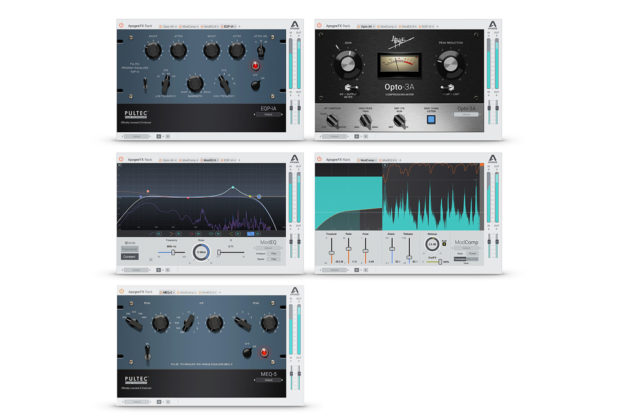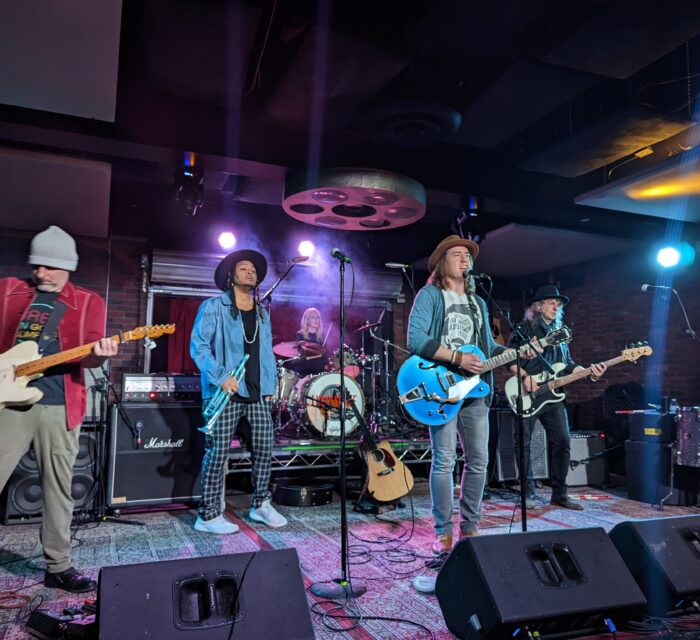Apogee Electronics has the Apogee FX Rack; it's a set of five mono or stereo processors configured in a virtual rack plug-in. Any of the five maybe used alone or in a chain, in any order and with up to six of them in the rack and in a single plug-in insert slot. FX Rack runs Native AU/VST/AAX in host DAWs or in hardware DSP in Apogee Element Series and Ensemble Thunderbolt interfaces.
I was immediately attracted to ModEQ 6, a six-band parametric equalizer with both proportional and constant Q modes available. All six bands have a full 20Hz to 20kHz range that overlap each other.
The two center mid-range bands can be either peak or notch filters with Qs up to 10. Each section will boost or cut of up to +/-24dB. There are two more peaking or shelving sections also with both proportional and constant Q choices. Lastly, there is both a low pass and high pass filter sections with 6dB or 12dB/octave slopes. At the 12dB/octave slope, the Q control fader will provide a resonant peak or dip at the frequency selected. I liked the way the handy spectrum analyzer with its basic controls worked to inspect its basic operation.
I found the ModComp processor to be a full-featured, modern compressor/limiter with both a high pass filter and peak/shelf equalizer and adjustable Q all fitted into its side-chain.
ModComp has a graphical display of the exact nature of its non-linear transfer function. This feature helps in deciding between the three Styles of compressors offered: Punch, Leveler and Easy. Punch and Leveler differ only in the range of values of adjustable Attack and Release time constants offered, whereas Easy has internally fixed values--no controls.
Besides a Wet/Dry control, ModComp has a Makeup Gain control or you can toggle Auto for automatic makeup gain. ModComp works wonders on the (sometimes) difficult dynamics of vocals or entire stereo mixes. It can sound super clean or much more colorable with a few mouse moves!
If you long for a familiar looking and simple-to-use compressor, the third processor is called Opto-3A. It is a leveling amp with a choice of either limiter or compression ratios. Located below its GUI and right next to its Wet/Dry control are extensive controls for setting up side-chain processing.
The High Pass control sets the amount of low frequency energy triggering compression--it ranges from 20Hz to 250Hz. The HF Contour control adjusts from Flat to either Cut, where high frequencies are rolled-off in the side-chain, or Boost where they are increased. This is like the pre-emphasis control that was standard on the vintage tube-based Teletronix LA-2A Leveling Amps. The controls were placed on the back of the unit out of reach. There is also a Side-Chain Listen button to monitor while adjusting these controls--this is an awesome feature.
I enjoyed using Opto-3A on a pair of drum overhead tracks with the HF Contour in Boost mode to cause more compression on cymbal crashes.
Officially licensed and endorsed by Pultec® Pulse Techniques, the EQP-1A EQ is a super-realistic model of the famed tube equalizer developed in the 1950s. The same frequency choices are here along with the exact same front panel look and operation including the ability to boost and cut at the same frequency at the same time. This produces the classic sound resonant peak heard on so many records. The Pultec EQ was made for electric guitars, pianos and vocals with its smooth sound even when boosting heavily. It works like a simple tone control.
The sixth processor is the Pultec MEQ-5, the coveted mid-range equalizer and companion to the EQP-1A. This three-band beauty I found excellent for carving vocals, bass guitars and drum kits. It works exactly like the hardware model.
All these plug-ins come with a solid selection of presets to get you going and I found them all super useful tools!
Apogee FX Rack includes EQP-1A, MEQ-5, Opto-3A, ModEQ 6 and ModComp and they sell for $449 MSRP. They are also sold individually.
apogeedigital.com/products/apogee-fx-rack
Barry Rudolph is a recording engineer/mixer who has worked on over 30 gold and platinum records. He has recorded and/or mixed Lynyrd Skynyrd, Hall & Oates, Pat Benatar, Rod Stewart, the Corrs and more. Barry has his own futuristic music mixing facility and loves teaching audio engineering at Musician’s Institute, Hollywood, CA. He is a lifetime Grammy-voting member of NARAS and a contributing editor for Mix Magazine. barryrudolph.com













